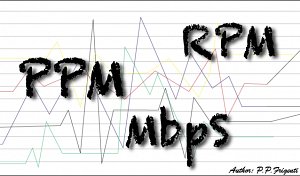Consumers often deceived by productivity metrics. How perception can fool human perspectives.

Time is one of the few things that cannot be bought. Very busy consumers are willing to spend money to save from time printing articles, downloading movies and buffering videos, and taking care of house-businesses such as cooking or cleaning. These consumers are happy to pay more for products that print more pages per minutes, “ppm”, for connections that download more megabytes per second, “mbps”, and washing machines with faster rotation and higher rotations per minute, “rpm”. Those acronyms are nothing more than metrics that seller use to give an idea of the speed of the products while buyers consider when buying a product. Productivity metrics are the essential metrics used in the choice of products in a wide range of competitive market offers.
According to the study, consumers are often fooled by productivity metrics, such as pages printed per minute or megabytes downloaded per second, due to incorrect notions about the effective outcome of productivity increases, and the effective potential time saved on products use.
The study was carried out by Bart de Langhe, assistant professor of marketing at the Leeds School of Business, University of Colorado at Boulder, and Stefano Puntoni, professor of marketing at the Rotterdam School of Management, Erasmus University, the Netherlands.
“It’s true that the faster something works, the more time the consumer will save,” write Bart de Langhe (University of Colorado) and Stefano Puntoni (Erasmus University). “But what consumers often don’t realize is that once a product is already fast, slight increases in its speed save proportionately less and less time.”
The current study is the first one that takes in account the productivity metrics in another perspective, analysing how they affect consumers’ perception of time saving as well as their willingness to pay for a certain amount of perceived time saving. The study focused on three main products that are associated to time metrics: Internet connections, printers, and food processors. In some cases the consumers were given the productivity metrics, while in others they knew only the time metrics. Finally, in other cases, they were not given specific metrics.
De Langhe and Puntoni’s study explains that often consumers give too much credit to productivity metrics, overestimating the benefits of productivity increments in high-productivity contexts in comparison to the benefits of productivity increments at low/medium productivity levels. For instance, according to the study, consumers would be more willing to pay to choose a Internet connections that is seven second faster when the speed goes from nine seconds to two than when it goes to sixteen to nine.
“Manufacturers assume that consumers can accurately translate changes in a productivity metric to changes in relevant benefits. However, our findings suggest that this assumption is incorrect,” de Langhe and Puntoni reported. “We don’t think that marketers have been wilfully taking advantage of consumers in this regard. But given the results of our study, any decision to rely on such consumer misunderstanding now becomes an ethical one.”
Written by: Pietro Paolo Frigenti
Sources: De Langhe, B., Puntoni, S. (2015), Productivity Metrics and Consumers’ Misunderstanding of Time Savings, Journal of Marketing Research
